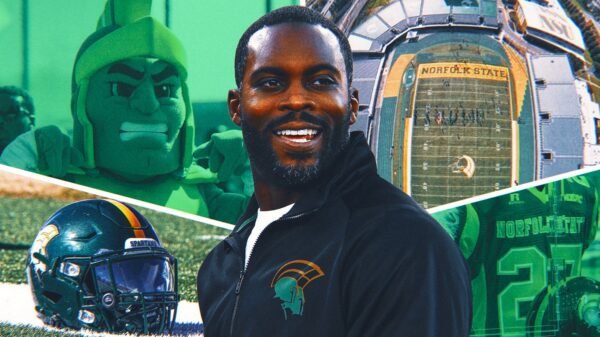Sideline-to-helmet communications garnered both praise and frustration in Week 1 of college football. A notable instance occurred when Alabama’s offensive coordinator, Nick Sheridan, found himself racing from the press box to the field mid-game, a situation he had not anticipated. This sudden shift was necessary for him to continue relaying plays to quarterback Jalen Milroe during the matchup against Western Kentucky.
The urgency arose because the Hilltoppers’ headsets malfunctioned, a part of a new communication system introduced this season. Due to this rule, Alabama was also unable to utilize their headsets, compelling Sheridan to make a hurried descent to maintain communication with Milroe. “I thought our staff did a great job because that’s something you don’t practice,” remarked Alabama head coach Kalen DeBoer following their impressive 63-0 victory.
The introduction of helmet communication systems allows a single designated player on each team—typically the quarterback on offense and the primary play-caller on defense—to receive voice instructions from the sidelines until 15 seconds remain on the play clock. This system, which was trialed during bowl games last season, aims to streamline communication by reducing the reliance on hand signals from coaches.
Initial reactions to this technology have been mixed. “It helped us some, but it kept messing up,” shared Mike MacIntyre, head coach of FIU, whose team faced a 31-7 defeat against Indiana. He expressed confusion over the recurring issues with the communication system.
Even when the headsets function properly, challenges remain, particularly with crowd noise. The opening game of the season took place in Ireland, where Georgia Tech faced Florida State in front of 47,998 fans. Despite the smaller crowd size by major college football standards, the noise level was significant. Georgia Tech quarterback Haynes King often found himself covering the ear holes of his helmet, struggling to hear the calls from the sidelines.
“You probably saw me cover my ears a couple of times, trying to get it, ‘What’d you say?’” said East Carolina linebacker Zakye Barker after his team’s win over Norfolk State. He noted that the noise was a positive sign, indicating strong fan support.
The debut of these communication systems added an intriguing layer to the opening weekend of college football. Some teams, like UTEP during their game against Nebraska, even allowed broadcasters to share live audio from coaches to players, providing fans with a unique glimpse into the action.
However, clarity was often lacking, resembling walkie-talkie audio quality at best. “It was definitely different,” commented Georgia quarterback Carson Beck after their win over Clemson. He appreciated the system but acknowledged that it still required players to frequently check sideline signals.
TCU quarterback Josh Hoover, who led his team to victory against Stanford, expressed satisfaction with the communication process. “I thought it went well. Pretty smooth for the first time out,” he stated.
Despite the advancements, helmet communication has not entirely replaced traditional methods like hand signals and placards. Miami (Fla.) prepared for potential crowd noise during their game against Florida by having multiple play-calling strategies in place.
Fortunately for Miami, their headsets worked well, and quarterback Cam Ward humorously pointed out to Florida fans that their crowd was not as loud as anticipated.
Wisconsin coach Luke Fickell highlighted the importance of improving communication as the season progresses. “Game 1 to Game 2, you’ve got to find some of your biggest jumps,” he said, emphasizing the need for teams to adapt and refine their use of technology.
Not every player has access to a communication device in their helmet, leading to complications for some teams. For instance, North Carolina State linebacker Caden Fordham, who had the headset, was ejected for a targeting penalty early in the game against Western Carolina. This forced the team to rely on linebacker Sean Brown for on-field communication.
Western Michigan faced a similar situation when linebacker Jacob Wahlberg was ejected against Wisconsin, leaving the team without their primary communicator for a significant portion of the game. “It actually is a bigger loss than maybe in the past,” lamented Western Michigan coach Lance Taylor.
This season’s introduction of sideline-to-helmet communication systems has certainly changed the dynamics of college football, presenting both opportunities and challenges for teams as they adapt to the new technology.












































